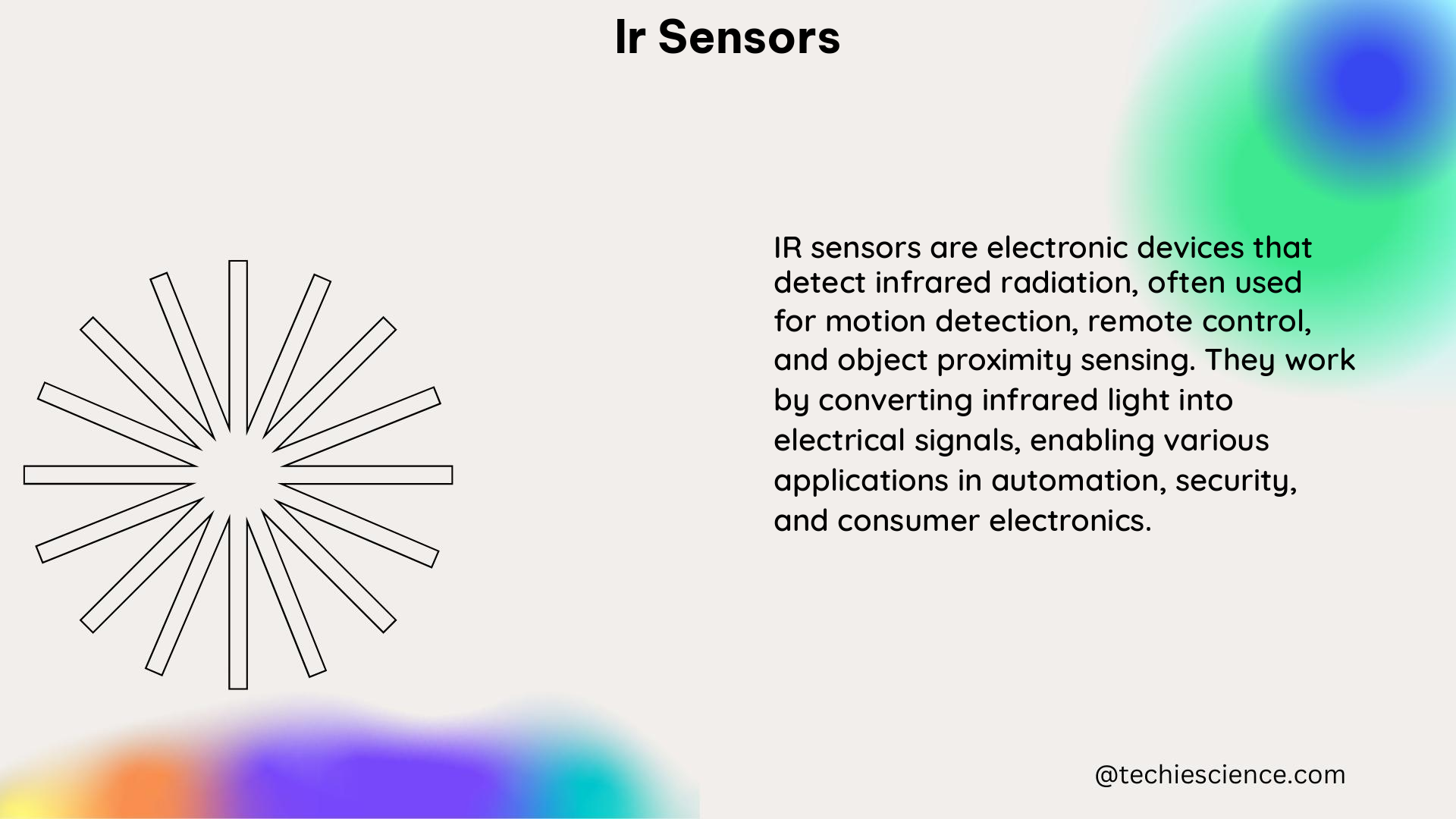Infrared (IR) sensors are versatile devices that detect and measure infrared radiation, enabling a wide range of applications, from distance measurement and gas analysis to food composition analysis. This comprehensive guide delves into the technical details and practical applications of IR sensors, providing a valuable resource for science students and enthusiasts.
Understanding the Fundamentals of IR Sensors
IR sensors operate by detecting the infrared radiation emitted or reflected by objects. Infrared radiation is a type of electromagnetic radiation with wavelengths longer than those of visible light, typically ranging from 700 nanometers (nm) to 1 millimeter (mm). IR sensors can be classified into two main types: passive IR sensors and active IR sensors.
Passive IR Sensors
Passive IR sensors detect the infrared radiation emitted by objects, such as the heat signature of a person or animal. These sensors are commonly used in motion detectors, security systems, and thermal imaging applications.
Active IR Sensors
Active IR sensors emit infrared radiation and detect the reflected or scattered light. These sensors are used for distance measurement, object detection, and proximity sensing. The distance can be calculated using the time-of-flight (ToF) principle, where the sensor measures the time it takes for the infrared light to travel to the object and back.
Distance Measurement with IR Sensors

One of the primary applications of IR sensors is distance measurement. The distance can be calculated using the inverse-square law, which states that the intensity of light is inversely proportional to the square of the distance from the source. The formula for the inverse-square law is:
I = P / (4πr^2)
Where:
– I is the intensity of the light
– P is the power of the light source
– r is the distance from the light source
For example, the Sharp GP2Y0A21YK0F IR sensor has a detecting range of 10 to 80 cm, with a detecting angle of 15 degrees. The sensor measures the distance by detecting the amount of infrared light that is reflected back to the sensor.
Numerical Problem:
Suppose an IR sensor emits 10 mW of infrared radiation and the intensity of the reflected light at a distance of 20 cm is measured to be 0.5 mW/cm^2. Calculate the distance of the object from the sensor.
Given:
– Power of the light source (P) = 10 mW
– Intensity of the reflected light (I) = 0.5 mW/cm^2
– Distance (r) = unknown
Using the inverse-square law:
I = P / (4πr^2)
0.5 mW/cm^2 = 10 mW / (4π × r^2)
r^2 = 10 mW / (4π × 0.5 mW/cm^2)
r = √(10 / (4π × 0.5)) = 20 cm
Therefore, the distance of the object from the sensor is 20 cm.
Gas Analysis with IR Sensors
IR sensors can be used to analyze the composition of gases by detecting the absorption of infrared light at specific wavelengths. This principle is based on the Beer-Lambert law, which states that the absorbance of light is directly proportional to the concentration of the absorbing species. The formula for the Beer-Lambert law is:
A = ε × b × c
Where:
– A is the absorbance of the light
– ε is the molar extinction coefficient of the absorbing species
– b is the path length of the light through the sample
– c is the concentration of the absorbing species
For example, a low-cost calibration method for an infrared sensor array has been proposed for the quantitative analysis of natural gas. This method can achieve an accuracy level of less than 3% for the detection of methane, ethane, and propane.
Chemistry Equation:
The absorption of infrared light by a gas can be described by the following equation:
I = I0 × e^(-ε × b × c)
Where:
– I is the intensity of the transmitted light
– I0 is the intensity of the incident light
– ε is the molar extinction coefficient of the absorbing species
– b is the path length of the light through the sample
– c is the concentration of the absorbing species
By measuring the intensity of the transmitted light (I) and the incident light (I0), the concentration of the absorbing species (c) can be calculated.
Food Analysis with IR Sensors
IR sensors can also be used to analyze the composition of food, such as breast milk, by detecting the absorption of infrared light at specific wavelengths. This technique is known as near-infrared spectroscopy (NIRS) and involves the use of chemometrics, which is the use of statistical and mathematical methods to analyze the spectral data.
For example, a portable NIRS instrument has been developed for the analysis of breast milk. This instrument can achieve a correlation coefficient of 0.841 for fat quantification, 0.512 for protein quantification, and 0.741 for carbohydrate quantification.
Figures and Data Points:
The performance of the NIRS instrument for breast milk analysis can be summarized in the following table:
| Nutrient | Correlation Coefficient |
|---|---|
| Fat | 0.841 |
| Protein | 0.512 |
| Carbohydrate | 0.741 |
These results demonstrate the potential of IR sensors for the accurate and non-invasive analysis of food composition.
Advanced Applications of IR Sensors
IR sensors have a wide range of advanced applications beyond the ones discussed above. Some of these include:
- Thermal Imaging: IR sensors can be used to create thermal images, which can be useful in applications such as building energy efficiency, medical diagnostics, and industrial process monitoring.
- Gesture Recognition: IR sensors can be used to detect and recognize hand gestures, enabling intuitive user interfaces for various devices and applications.
- Flame Detection: IR sensors can be used to detect the presence of flames, which is important for fire safety and industrial process monitoring.
- Gas Leak Detection: IR sensors can be used to detect the presence of specific gases, such as methane or carbon monoxide, which is important for safety and environmental monitoring.
- Moisture Sensing: IR sensors can be used to detect the moisture content of materials, which is important for applications such as agriculture, construction, and textile manufacturing.
Conclusion
IR sensors are versatile and powerful tools that have a wide range of applications in various fields, from distance measurement and gas analysis to food composition analysis. By understanding the fundamental principles and advanced applications of IR sensors, science students can unlock new opportunities for research, innovation, and problem-solving.
References
- Stabilize Data from IR Distance Measuring Sensor
- Low-Cost Calibration Method for Infrared Sensor Array for Quantitative Analysis of Natural Gas
- Portable NIRS Instrument for the Analysis of Breast Milk
- Infrared Sensors: Theory, Modeling, and Applications
- Inverse-Square Law
- Beer-Lambert Law
- Chemometrics

Hi, I am Sanchari Chakraborty. I have done Master’s in Electronics.
I always like to explore new inventions in the field of Electronics.
I am an eager learner, currently invested in the field of Applied Optics and Photonics. I am also an active member of SPIE (International society for optics and photonics) and OSI(Optical Society of India). My articles are aimed at bringing quality science research topics to light in a simple yet informative way. Science has been evolving since time immemorial. So, I try my bit to tap into the evolution and present it to the readers.
Let’s connect through